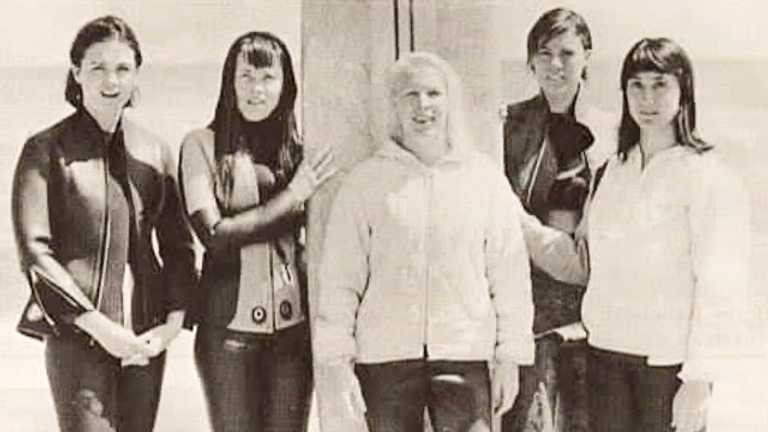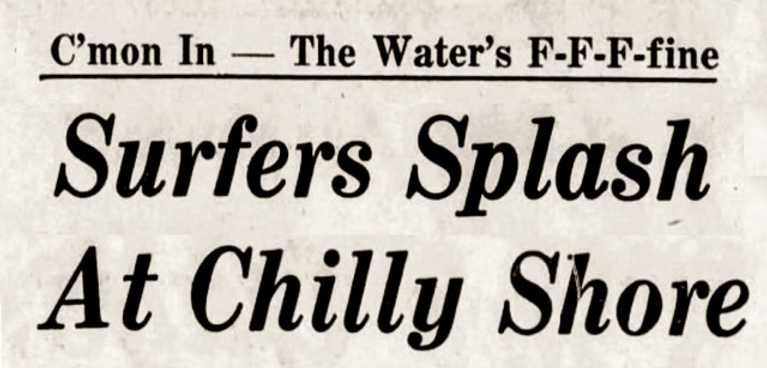SUNDAY JOINT, 3-3-2024: POLAR BEARS GET FREE COFFEE AND DOUGHNUTS

Hey All,
Janice Domorski of Bradley Beach, New Jersey, was the first East Coaster to make the finals of a World Surfing Championships event (Puerto Rico ’68), and during the second half of the ’60s she parked herself on the winner’s podium from Miami to Narragansett. Read Janice’s EOS page here, and skip ahead to 17:15 on this video to catch an eyeful of her classy upright riding style—for a hot minute there, Domorski’s pale Monmouth County fingers were brushing up against the ’68 world title trophy!
More often than not, the best part of researching lesser-known surfers is getting sidetracked into the age and setting that shaped that person and brought them to prominence. In Janice’s case, I was charmed by an accidentally amazing 1965 Surfing East magazine article titled “Surf-Hers”—eye-roll the title all you want, but “Surf-Hers” is Joycean compared to the forced-clever wordplay I often produced during my mostly forgettable SURFER editorship in the 1980s—which gives us a keyhole view of a recent surfing contest at Point Pleasant Beach, NJ, and the five women finalists. Domorski, it goes without saying, won the event.


What struck me is how close we are here to the Genesis of women’s surfing in this corner of the world. The sport is still new to all five competitors. “Staten Island resident Margie Nelson was the third-place winner and the veteran surfer of the group, having learned to surf two years ago.” Because the writer goes out of her way to tell us that “each girl owns her own wetsuit and board,” the assumption must have been that, up to this point, the common way for a woman to surf was to borrow equipment from a male surfer, a boyfriend, or brother. Yet the vibe at Point Pleasant Beach in 1965, just as it was for both of the 2024 WCT events held so far, was animated more by the women than the men. “These five girls were stars of the show because of their fighting spirit and their enthusiasm,” the Surfing East article says. Or, as Caitlin Simmers put it last month after her inspiring Pipe Pro win, “Pipeline for the fucking girls!”
From there it was but a short jump into a second and much deeper rabbit hole, as I learned about what I assume is the original cold-water-for-cold-water’s-sake contest, the Polar Bear Surfing Meet, in Ocean City, NJ. The first one was held on December 29, 1965. Two bucks to enter, but the price included a 50-cent food credit, and I couldn’t find a White Castle ad from that year to make the point that four bits was enough to buy lunch, but here’s a 1965 menu from McDonald’s, which if anything was pricier than White Castle. Contestants also got free hot chocolate and doughnuts. For safety reasons, a local newspaper noted, nobody was allowed in the water before the event, and “all competitors must be fully garbed in wetsuits.” The article continued: “Two fire drums will be provided for warmth on the beach.”


One-hundred surfers signed up, 3,000 people came out to watch, and the whole thing was over and done in less than five hours. How small was the surf? In the Atlantic City Press coverage, we first hear about “poor waves” and “light waves,” then here comes the kicker: “The US Coast Guard sent a patrol boat from Great Egg Harbor for a portion of the contest [in hopes] that the vessel would create more surf for the competitors.” What I think this means is the boat buzzed the contest area, back and forth, to try to generate waves from the wake, and I love that the community, military included, got so behind the event that they came up with this plan on the spot.
Sidebar on the Polar Bear judging format. “The young competitors gave even the smallest ride everything they could,” the Press noted. “The judges gave three points each on the basis of take-off, ride, and cut-out, with one point for ‘fancy work.’” So again, what I think this means is a 10-point scale for each ride—“fancy work” is yours for the taking, Joe Turpel—but who cares, what we’re really here for is the air and water temperatures, am I right? Just how cold was it for those polar bear surfers?

The article does not say. Incredible. We find out the contest was dedicated to Snowflake, the Philadelphia Zoo’s one-week old polar bear, but we never learn, specifically and imperially, what kind of insane conditions these surfers competed in.
So that kicked me to 1966 and the Second Annual Polar Bear Surfing Meet, and there it is in the first paragraph: snow on the beach and 34-degree water (other papers reported 40-degree water, 30-degree air), and for all you surf-geezers and geezettes who practiced the Sport of Kings during winter months in the 1960s and recall what wetsuits were like in that celebrated bygone age—vulcanized cardboard, basically, in terms of fit and comfort—I see your lips turning blue from here.
Now here comes the fancy work as I bring this Joint full circle by telling you that the winner of the ’66 Polar Bear was . . . yes, Janice Domorski.
Thanks for reading, everybody, and see you next week.
Matt
PS: Ocean City, NJ, same location as the photos above, but two years later and 50 degrees warmer.

[Photo grid, clockwise from top left: vintage White Castle ad; German beachgoers and polar bear; Janice Domorski in the finals of the ’68 World Championships; Bradley Beach postcard; US Coast Guard cutter; Domorski on the beach in PR. Competitors at the ’65 Point Pleasant Beach contest with Domorski on far right. Domorski winning the event. Photos from the 1965 Polar Beach Surfing Meet, Ocean Beach, NJ. Headline from the 1966 event. Ocean City, summer of ’68—the opposite of polar bear surfing.]